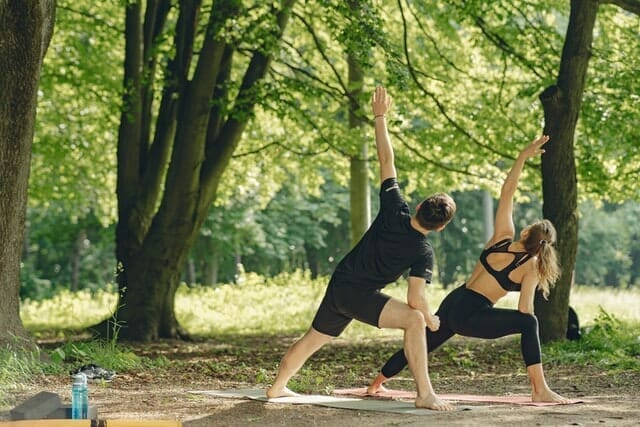Stretching, or stretching, is a set of physical exercises that are a patent for strengthening, while protecting and better recovering muscles. Through stretching, muscles become more stretchy and more susceptible to shaping. At the same time, regular stretching means less likelihood of soreness, cramps, injuries and even degenerative changes. Unfortunately, muscle stretching is often neglected by exercisers. Many people skip it, believing it to be unimportant and not really of any benefit. However, Stretching is of colossal importance, and not only for the functioning of muscles, but also for our overall physical form, immunity and well-being. What is stretching? What are the types of stretching?
Table of contents
Stretching exercises after training – do not underestimate them!
For every person who trains, stretching should be a permanent part of the exercise program. However, next to the warm-up stretching is the second most often neglected element of training, and this applies both to people practicing strength training, as well as those engaged in aerobic and interval training. Very often we forget, or do not realize at all, that the lack of post-workout stretching can result in contraction and stiffness of muscles, ligaments and joints, and progressive abnormalities in the musculoskeletal system.
Lack of stretching can also result in increased susceptibility to injury, slower recovery processes, and less effective and slower muscle tissue growth. What is worse, it may contribute to a decrease in the general efficiency and fitness of the body, more severe feeling of joint and muscle ailments, more severe feeling of pain in the muscles and joints, more severe feeling of pain in the muscles and joints.It can also lead to more severe joint and muscle pain, soreness, strains, swelling and various types of pain.
If you belong to a wide group of people who do not care much about stretching, it is better to change your approach and start practicing this set of exercises as soon as possible. We will quickly find out how many benefits stretching gives. It is enough that we allocate 10 minutes or 15 minutes more to our standard workout, because that is how long post-workout stretching exercises last. It’s also worth starting to practice pre-workout stretching dynamic, especially if you want to maximize your training efficiency.
What is stretching?

In the life of professional athletes, stretching, or stretching, whether performed after or before workouts and competitions, is an important, even indispensable part of the activity. And for good reason. Anyone who is aware of how the muscles and the entire musculoskeletal system work, and what effects can bringeffects of not stretching and to what extent it can improve our efficiency, attaches great importance to it.
Stretching post-workout is a range of exercises applied to different parts of the body and aimed at calming, relaxing and stretching the muscles, restoring their goodStretching post-workout is a range of exercises used in different parts of the body and aimed at calming, relaxing and stretching the muscles, restoring their good disposition, preparing them for the next workout and protecting them from post-workout shortening, stiffness and various ailments.
Stretching also has a positive effect on other parts of the musculoskeletal system, including joints, ligaments and tendons. Stretching exercises are also a way to stimulate the flow of synovial fluid within the joint capsule, and thus improve The degree of nourishment of the joint structures, increased joint mobility and more efficient reconstruction of joint cartilage. This is especially important information for people struggling with cartilage damage or wear and limited joint mobility.
How do stretching exercises work?
Typical stretching exercises mainly involve tensing the muscles and then slowly relaxing them. The right way of breathing also plays a large role here. Inhale through the nose and exhale through the mouth. Breathing should be slow, easy, fairly deep and steady. It is worth to focus as much as possible on breathing, which will allow us to better relax, calm down and unwind.
Effect of stretching on the body
Properly performed stretching improves blood circulation throughout the body, including the muscles. Thanks to this the muscles are well oxygenated and supplied with a large dose of valuable nutrients and building materials. This promotes their faster recovery, increased strength and endurance, and more efficient growth.
Interestingly, stretching exercises have a beneficial effect not only on the joint and muscle system, but also on the nervous system and general mental condition. Performing stretching, we can quickly and effectively relax the muscles tired after a workout, but also remove any tension from the whole body, lower the body’s fatigue, and reduce the risk of muscle fatigue.The stretching can quickly and effectively relax the muscles tired after a workout, but also remove any tension from the whole body, reduce stress levels, calm down and relax, regain a good, stable mood.
Stretching also provides stimulation of the so-called deep sensation, so we gain greater awareness of our own body and the location of various parts of the body at any given moment. This is a very important property of stretching from the point of view of people suffering from coordination and balance disorders, having problems with walking or maintaining a stable, straight posture.
Doing stretching exercises also results in reduction of numerous ailments, such as tension headaches, cramps, coordination and balance disorders, back pain. There is a reason why stretching is recommended for people who lead sedentary lifestyles – simple stretching exercises can reduce the risk of joint deformationSimple stretching exercises can reduce the risk of joint deformities, strains and degeneration, which often occur in the case of not practicing any sport or generally low level of physical activity on a daily basis.
It is also worth getting used to regular stretching exercises if your job involves spending many hours in one position, such as sitting or standing. In the case of such professions, it is easy to overload joints, problems with the spine, circulation disorders, and irregularities in the work of internal organs. Meanwhile, systematic (preferably daily) stretching helps to move and eliminate tension, improves mobility and jointIt also stimulates blood flow, increases muscle flexibility and prevents the development of adverse changes and pain.
Stretching and training
Whether your primary activity is running, bodybuilding, fitness, or another sport, the stretching is a good way to avoid injury and strain. It also carries with it a palette of other benefits for our muscles and joints.
What does stretching do?
- Strengthening of muscles, ligaments and tendons,
- increased muscle flexibility,
- better joint mobility,
- less risk of injury,
- improving blood supply to muscles, increasing their strength and endurance,
- more efficient muscle work – faster body shaping, more efficient muscle mass gain,
- faster regeneration after training,
- reduction of joint and muscle ailments resulting from increased physical effort,
- better work of the entire musculoskeletal system,
- improved range of motion, improved motor skills,
- muscle relaxation, easier entry into a state of relaxation after training,
- stress relief, improved well-being,
- faster achievement of training goals.
Check out the way to efficient post-workout recovery: Nutrigo Lab Regeneration

How often do I stretch?
Stretching exercises can be performed both before and after training. Post-workout stretching is performed for about 10-15 minutes immediately after the exercise session. Pre-workout stretching is done after a light warm-up, just before you start exercising.
Perform stretching dynamic before your workout and stretching static after your workout.
Remember that the stretching exercises cannot be too intense, not adapted to our current condition. They certainly cannot be combined with stretching of muscles beyond the limits of our endurance, and they cannot cause pain. In this way you can lead to tearing of muscle fibers and injuries.
Type of stretching – which one to choose and when to perform?

Both starting the training proper without any preparatory exercises, as well as its abrupt termination without a retreat, is unfavorable for many reasons. First of all, it reduces training productivity and carries a higher probability of injury.
Static stretching and dynamic stretching are the two most commonly used types of stretching. There are also other methods of stretching, including:
- rotational exercises which involve rotational movements to stretch and warm up the joints,
- stretching post-isometric method (stretching PNF) – used mainly in conditions of overload, injury and degeneration, uses the physiological mechanism of reflex to stretch,
- stretching ballistic – a stretching exercise for advanced exercisers that involves performing rapid pendulum movements such as swings.
Massages and massages combined with acupressure are also an effective way to stretch exhausted muscles.
Stretching dynamic
TheStretching dynamic is performed prior to exercise, after the initial warm-up. Its purpose is to warm up and oxygenate the muscles in order to make them more efficient during exercise and more resistant to fatigue.
Stretching Dynamic stretching involves stretching the muscles by performing a series of about 8 exercises of about 10 repetitions each (preferably similar to the exercises performed during basic training). Once the dynamic stretching is complete, the muscles return to their size while gaining more strength, stretch and endurance.
Stretching Dynamic stretching should include exercises for all parts of the muscles, but the most attention should be paid to those parts that will work most intensively during the main training.
Performing dynamic stretching translates into improved coordination and balance, improved flexibility and muscle dynamics, and increased fluidity and range of motion. As a result we gain greater training potential, we can train longer and more intensively.
Stretching dynamic – examples of exercises
- arm swings,
- leg swings,
- arm circles,
- hip circles,
- twists,
- squats,
- jogging with arm circles,
- skip A, skip B, skip C,
- push-ups,
- jumping,
- running in place.
Check: Weight Loss Supplements – Ranking
Stretching static
In static stretching the stretching of muscles takes place when the body is at rest and not using movement as in the case of dynamic stretching.
Static Stretching stretching is based on assuming body positions that force intense stret ching of a given muscle or muscle part (at the limit of our mobility, but without exceeding it – muscles must not hurt when stretching). In such a position you should hold for about 20-30 seconds, and then relax your body for a few seconds, after which you can move on to the next exercise. We perform 6-8 exercises of about 10 repetitions at a time.
Static stretching is performed after the training. It is a form of rest and preparation for the recovery process for the muscles and protects them from soreness, excessive tension and shortening.
Static stretching should not be performed before a workout as it can contribute to decreased muscle strength and endurance and even increase the risk of injury. stretching dynamic is reserved for the time before your workout.
Stretching static – examples of exercises
- Exercise in the standing position – we stand with joined knees, draw one foot to the buttocks, hold for 30 seconds, return to the starting position, then do the same with the other foot.
- Kneeling exercise – so called cat’s back, lifting the entire back and hips high up, hold for 30 seconds, relax the muscles.
- Exercise in the lying position – lie on your back, spread your arms to the sides, pull the leg bent at the knee to the opposite side, hold for 20 seconds, return to the starting position, then do the same with the other leg.

